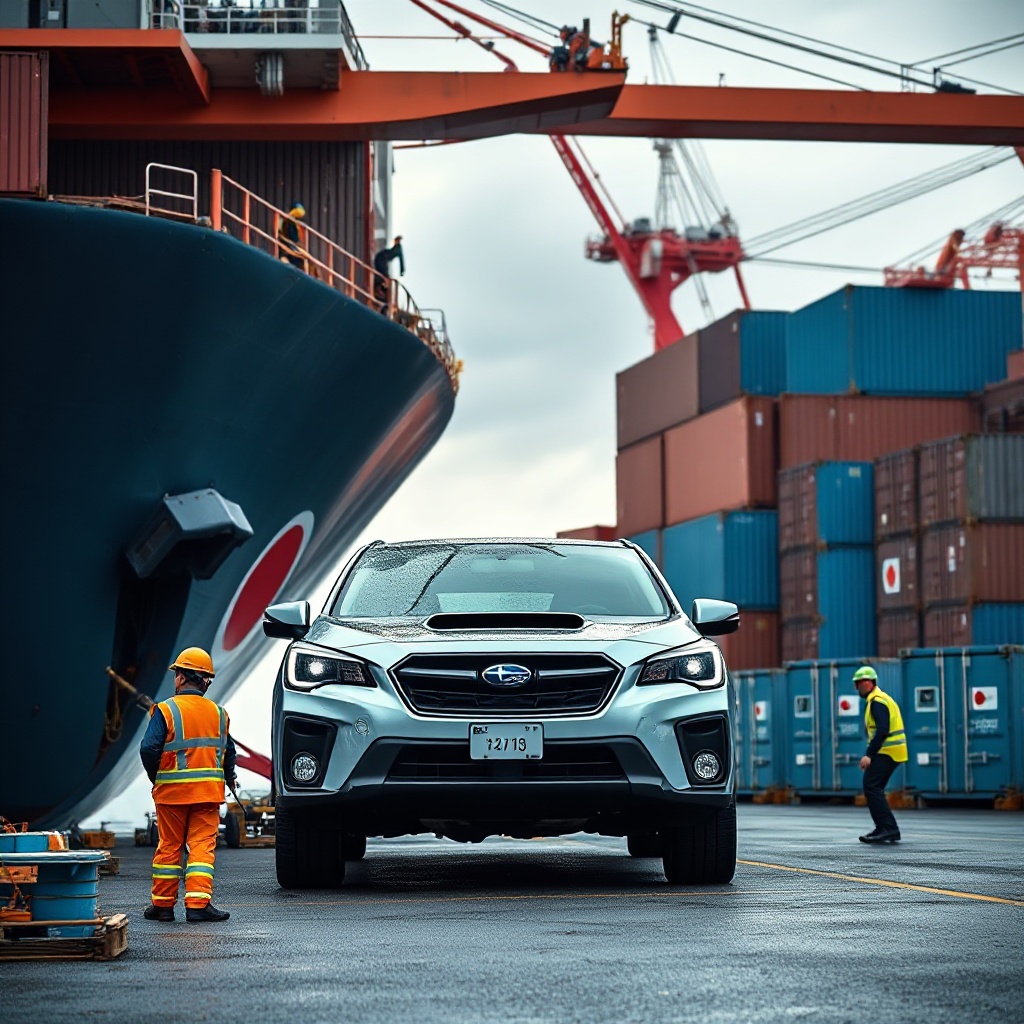
Canada pivots auto supply chains as Subaru sources vehicles from Japan instead of US to avoid 25% retaliatory tariffs, reshaping North American trade dynamics.

Drivetech Partners
Canada's 25% retaliatory tariffs on U.S.-built vehicles have sparked a dramatic reshuffling of automotive supply chains across North America, with Subaru leading the charge by pivoting away from American production. Taking advantage of the Canada-Japan free trade agreement, Subaru Canada is now sourcing the majority of its vehicles directly from Japanese factories to completely bypass the steep tariffs that would otherwise drive up prices and squeeze profit margins in the Canadian market.
Key Takeaways
Canada's 25% retaliatory tariffs on U.S.-built vehicles took effect April 9, 2025, forcing automakers to restructure their supply chains
Subaru Canada is shifting vehicle sourcing from U.S. factories to Japan, leveraging the Canada-Japan free trade agreement
The deeply integrated North American auto industry faces unprecedented disruption with parts typically crossing borders multiple times during production
Consumers could see price increases up to $12,200 on certain models as manufacturers adapt to the new tariff landscape
Limited exemptions and rebate systems provide only partial relief as companies scramble to maintain competitiveness
Canada's Retaliatory Tariffs Shock Auto Industry
The Canadian government's implementation of 25% tariffs on U.S.-built vehicles represents one of the most significant trade actions in recent North American history. These measures, which went into effect on April 9, 2025, directly respond to the Trump administration's earlier imposition of similar tariffs on Canadian automotive products. The Canadian tariffs apply to a broad range of vehicles, including passenger cars, SUVs, crossovers, vans, and light trucks under 5 tonnes.
Finance Minister François-Philippe Champagne announced the measures as part of an estimated CAD $155 billion package of retaliatory actions. The decision has sent shockwaves through automotive supply chains that have been integrated across North America for decades under previous trade agreements. The sudden implementation has left manufacturers scrambling to adapt their production and distribution strategies with minimal disruption to their Canadian operations.
Subaru Leads Strategic Pivot to Japan Amid Tariff War

Subaru Canada has emerged as a leader in adapting to the new tariff reality by drastically reducing imports from U.S. manufacturing facilities. Instead, the company is redirecting the majority of its vehicle sourcing to Japanese factories. This strategic shift capitalizes on the Canada-Japan free trade agreement, which allows Subaru to import vehicles without incurring the punitive 25% tariff that would apply to U.S.-built models.
The company's quick pivot demonstrates how manufacturers can protect their profit margins while maintaining competitive pricing in the Canadian market. This approach represents a broader industry trend as auto companies race to adjust their supply chains in response to the changing tariff environment. For Subaru, the move leverages existing Japanese production capacity while minimizing exposure to the volatile North American trade situation.
North American Auto Integration Under Pressure
The auto industry has developed a deeply integrated manufacturing ecosystem across North America, with vehicle components often crossing borders multiple times during the production process. This integration, built over decades of free trade, is now under severe strain due to the new tariffs.
The scale of this integration is remarkable:
U.S.-made content accounts for 74% of foreign value-added in vehicles imported to the U.S. from Mexico
Mexico and Canada together represent nearly half of U.S. imports and exports of motor vehicles and parts
Most vehicles produced in North America contain components that have crossed international borders numerous times
Six major U.S. auto industry lobbying groups have issued warnings about the severe supply chain disruption these tariffs will cause. Most auto suppliers lack the financial resources to adapt quickly to such abrupt changes, creating the potential for bottlenecks and production delays throughout the industry.
Consumer Impact: Rising Prices and Changing Options

Canadian consumers will feel the impact of these tariff changes through substantially higher vehicle prices and potentially reduced selection. Industry analyses estimate price increases of up to $12,200 for some models directly affected by the tariffs, as manufacturers pass on at least some of the increased costs to buyers.
The market is likely to see several significant shifts:
A notable reduction in U.S.-sourced vehicles on Canadian lots
Increased availability of Japanese, European, and other tariff-exempt imports
Possible delays in new model introductions as manufacturers reconfigure supply networks
Growth opportunities for manufacturers with non-U.S. production facilities serving the Canadian market
These changes will transform the vehicle shopping experience for Canadian consumers, potentially limiting choices in the short term while creating new options as manufacturers adjust their strategies to the new tariff reality.
Financial Stakes for Automakers and Economies
The financial implications of these tariffs are enormous for both individual companies and the broader North American economy. General Motors has warned that tariffs could cost the company up to $5 billion, highlighting the scale of the challenge facing major automakers.
The White House has estimated $100 billion in new revenue from auto tariffs, but economists predict this will come at the cost of short-term inflation and the potential for vehicles to become "luxury items" with prices out of reach for many consumers. The 25% tariff rate is significant enough to force substantial supply chain restructuring rather than simply being absorbed as a cost of doing business.
The Big Three North American automakers—Ford, GM, and Stellantis—have lobbied against the tariffs, citing inevitable price increases and long-term industry damage. Their integrated production networks across the U.S., Canada, and Mexico make them particularly vulnerable to the disruption caused by these trade measures.
Relief Measures and Exemptions Provide Limited Buffer
Both the U.S. and Canadian governments have implemented limited relief measures to reduce the most severe impacts of the tariffs. U.S. Customs exempted CUSMA-compliant Canadian automobile parts from tariffs effective May 1, 2025, though this exemption notably does not apply to automobile knock-down kits or parts compilations.
The U.S. has also created a rebate system where automakers finishing vehicles in the U.S. can receive a rebate on imported parts equal to 15% of the vehicle retail price in the first year, dropping to 10% in the second. Meanwhile, Canada is implementing a remission framework designed to incentivize production and investment while maintaining jobs.
A special exemption has been granted to residents of Campobello Island, New Brunswick, from the tariff countermeasures due to their unique geographical situation. However, these targeted relief measures provide only partial protection against the broader economic impact of the tariffs.
Manufacturing and Employment Shifts Across North America
The tariff war is already triggering significant shifts in manufacturing priorities and employment patterns across North America. There's potential for increased Canadian domestic production as companies seek to avoid tariffs by manufacturing within Canada, potentially creating new jobs in the Canadian automotive sector.
However, the highly integrated nature of the industry means these shifts are complex and challenging to implement quickly. Automotive parts manufacturers in Canada face particularly difficult supply chain decisions as their products often cross borders multiple times during the manufacturing process.
Flavio Volpe, president of the Automotive Parts Manufacturers' Association, has starkly warned that tariffs on auto parts would effectively "shut down manufacturing" due to the integrated nature of production. Long-term manufacturing investment decisions are being reconsidered across the continent as companies evaluate the evolving tariff environment and its implications for their production networks.
Future of Cross-Border Auto Trade in Question
The U.S. tariffs that triggered Canada's response were initially announced on March 27, 2025, with implementation beginning April 2, 2025. The 25% tariff rate on imported vehicles and parts represents a significant barrier to the free flow of automotive products that had characterized North American trade for decades.
Canadian retailers are now adjusting their inventory strategies to reflect the new supply realities, with product lineup changes likely as manufacturers evaluate profitability model by model. The Trump administration has stated that the goal of these tariffs is to boost domestic manufacturers at the expense of imports, but the integrated nature of the industry means the impacts are far more complex than a simple shift in production location.
The long-term implications for North American automotive trade remain uncertain, but it's clear that the industry is undergoing a fundamental restructuring that will reshape vehicle manufacturing, distribution, and sales across the continent for years to come.
Sources
Car and Driver - Canada Tariffs US Cars Imports
Canada.ca - List of vehicle products from the United States subject to 25 per cent tariffs effective April 9, 2025
Canada.ca - Canada announces entry into force of countermeasures against auto imports from the United States
S&P Global - Auto Tariffs Update: Relief, Complexity, Automakers
CBSA - Publications CN-AD CN25-15




